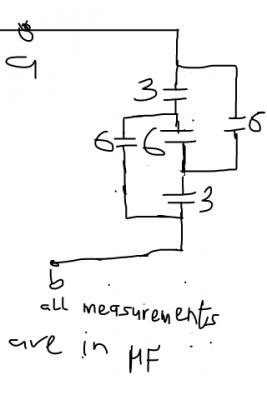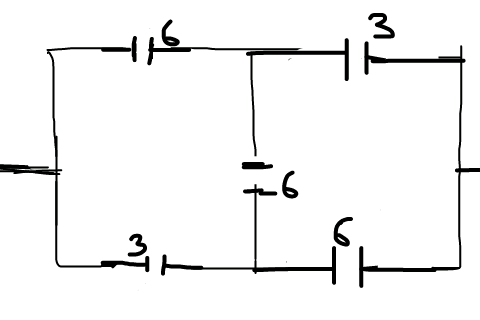-
Posts
14 -
Joined
-
Last visited
Content Type
Profiles
Forums
Events
Everything posted by Mozart
-
Please studiot, the "DELTA STAR TRANSFORMATION" and the "STAR DELTA TRANSFORMATION" processes as explained by the link you provided are not yet clear to me. I played around with that formular you used to solve for Z1 , I wanted solve for CBS so i thought that this might be the formular. Am I correct? are there any other known links that can explain this thing more clearly? Thank you all for your replies!!!
-
Thank You very much Studiot! I'm very happy! please. thank you once more! I'll get back to you with the Answer I'm very glad!!! you really tried for me!
-
Thank You Enthalpy! From what you have said so far, Sincerely speaking, I didn't quite understand you. I gather that the knowledge required to tackle that question is above my reach. Unless you are just referring me to Kirchhoff's Voltage and current rule! That will be very tedious! I just need a link with a similar question solved. If there is none, I'll be lift with no other alternative than to brain storm the question. I already have the answer. So there isn't a shortcut! ?
-
It's not a home work. I know that if two capacitors are in series, sum of each inverse of the capacitance is equivalent to the inverse of the effective capacitance. also, if they are parallel, that's simpler, just sum up the values. please, Just help me do this one! it's not an assignment. Infact, I already passed the course long ago. I just feel sad I can't solve it.
-
PLEASE, Help me out with this capacitance problem!!! I have been trying all my best to solve this question, most times, i end up in a dead lock and I leave it! I have just made a resolution to find the solution today. this is the original question; I redrew it and I had this; My problem is that there is a certain principle i think I should know in order to tackle that question, but i dont! any links to search?? We did the course last semester! how do I solve it? The question says I should find the effective capacitance. Thank You.
-
It's true. Thank you Studiot. I forgot that.
-
Study things within your range, google stuffs and do not make this site your first port of call when given assignments. Struggle on your own first before posting.
-
There are basically three ways to solve a quadratic eguation. 1. by factorisation 2. completing the square method 3. using the almighty formula. I see no lapses with you manipulations. you are nearly there.
-
@CaptainPanic, you probably are wrong. Well, actually, Robots are highly sophisticated. especially, the one with the human resemblance. but, Let's not loose sight of the fact that other technologies are sophisticated too. Due to the cheapness of human beings, you feel you can't involve capital, resources and brain power to make a robot that can shop, drive, sing, play the organ etc because you think they are probably simple tasks humans do gladly without much energy. Didn't it occur to you that the visual capability of a robot, or maybe, to catch a ball thrown to it involves lots of complexity? the robot has to sensor the object mid- air, with the programs already scripted into it's IC, It'll calculate the 3D position (x, y, and z. components and angle , ) get the velocity, and calculate it's exact position when it's an arms length and then catches it. for the robot to be able to grip anything that enters it's hand fastly in this case involves another process too. Yeah, actually if I'm correct, Then my point is that, no matter how sophisticated it might be, we only make the progress once. we always solve a complex puzzle once and look for another, so all robot engineers don't solve one particular problem individually once a clear solution is reached. The fate of robots come 2030 is wonderful. they will be accepted and made wildly especially in Africa.
-

how do you get the sine of an angle without calculator?
Mozart replied to calculot's topic in Mathematics
I think it's better to memorize sin 1-89, It'll save you alot of time. -
Daniel Foreman, I congratulate you for making that true observation. I understand you perfectly well. it isn't easy, such phenomenons aren't easy to tender a comprehensible backup explanation. For those of you trying to disprove his idea by using science, you are wrong. This has a hint on Einstein's Relativity idea. He is saying that time does not exist. there are only moments. time has it's origin from motion, from the fact that it takes 365.25 days for earth to revolve round the sun. time has no origin. time is manmade. assume that time does not exist, but moments do. time is just there for measurements. (to measure constant motion -of the earth. ) this remains a fact. so, disproving this with mere scientific understanding means you've not understood this point. thank you op Daniel Foreman, I congratulate you for making that true observation. I understand you perfectly well. it isn't easy, such phenomenons aren't easy to tender a comprehensible backup explanation. For those of you trying to disprove his idea by using science, you are wrong. This has a hint on Einstein's Relativity idea. He is saying that time does not exist. there are only moments. time has it's origin from motion, from the fact that it takes 365.25 days for earth to revolve round the sun. time has no origin. time is manmade. assume that time does not exist, but moments do. time is just there for measurements. (to measure constant motion -of the earth. ) this remains a fact. so, disproving this with mere scientific understanding means you've not understood this point. thank you op
- 325 replies
-
-2
-

Dielectrics (Please, somebody should help me out. )
Mozart replied to Mozart's topic in Homework Help
Hey. Please, I'm sorry. I actually needed help, but have gotten one now. I have managed to produce the solution myself. thanks all. -
a parallel plate capacitor has plates of dimensions 20cm by 20cm seperated by 2mm. The dielectric constant of the material between the plates is 5 and the plates are connected to a voltage source of 500V. calculate (a) the capacitance, (b) the charge on either plate, © the energy density, and(d) the total energy stored in the capacitor.
-
Try to join any IEEE (I Triple E) organisation in your area. It helped me get started. join the robotics setion.




